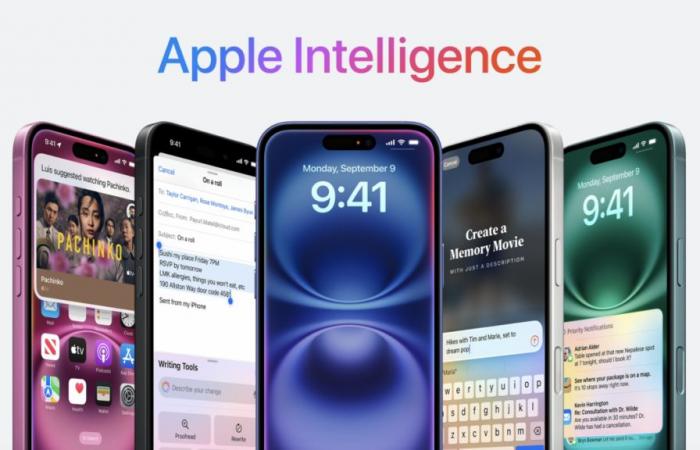Apple (AAPL) debuted its iPhone 16 smartphone line during its “Glowtime” event at its headquarters in Cupertino, Calif., on Monday. The phones come in four styles: the iPhone 16, the iPhone 16 Plus, and the premium iPhone 16 Pro and iPhone 16 Pro Max.
The new phones are Apple’s first designed specifically with its Apple Intelligence AI platform in mind and feature more powerful chips that can operate the software. The base iPhone 16 and iPhone 16 Plus now come with the same programmable Action button found on last year’s iPhone 15 Pro line.
Both the base iPhone 16s and the iPhone 16 Pros also get new dedicated touch-sensitive camera buttons that you can click to launch the camera app. You can then click again to take a photo or click and hold to take video.
A light press on the button brings up a new overlay that allows you to access controls like zoom. Third-party apps like Snapchat are also taking advantage of the camera button to quickly share your shots.
iPhone 16
Overall, the $799 iPhone 16 and $899 iPhone 16 Plus look similar to last year’s models, save for the way their rear cameras are arranged. They’re now stacked vertically to allow for spatial photos for use with the Apple Vision Pro headset.
Inside, iPhone 16 and iPhone 16 Plus get Apple’s new 3-nanometer A18 chip, which includes a 2x faster neural engine. Apple says the A18’s central processing unit is up to 30% faster than the one found in the iPhone 15 line and includes a 5-core GPU, which helps run Apple Intelligence, games, and camera features. Apple says the new chip will also improve the iPhone 16 lines battery life.
The iPhone 16s will also come equipped with computational photography software to create a 2x telephoto option that simulates an optical zoom via the standard wide-angle lens. The ultra-wide lens, meanwhile, gets upgraded to 48 megapixels.
Apple further says it’s bringing visual intelligence to the camera app that allows you to take a photo of something like a restaurant to get reviews of the place or take a shot of a flier for a concert and immediately add the info to your calendar. If you see a bike in person that you’d like to buy, you can capture a photo of it and then get a quick Google link to purchase it.
This sounds similar to Google’s existing Circle to Search feature for Android phones. I’ll have to see if it works as well as Google’s offering when I get my hands on it.
iPhone 16 Pro
The $999 iPhone 16 Pro and $1,199 iPhone 16 Pro Max get larger displays this time around, with the Pro’s screen jumping from 6.1 inches to 6.3 inches and the Pro Max’s screen increasing from 6.7 inches to 6.9 inches. The bigger displays come courtesy of thinner bezels that make the phone look more like a single sheet of glass from the front.
Story continues
Both Pro phones come with Apple’s new A18 Pro chip, offering better performance than the A18 found in the iPhone 16s. The processor’s CPU is 15% faster than the A17 Pro and uses 20% less power.
The Pro and Pro Max also get more powerful 48-megapixel fusion cameras, and 48-megapixel ultra-wide cameras. The Pro gets a new 5x optical zoom to match the Pro Max’s capabilities. The iPhone 15 Pro only offered 3x zoom.
Like the iPhone 16s, the Pros get the same camera controls via the new dedicated camera button, and later this year Apple will add a two-step shutter that locks onto a subject via a software update. You’ll also now be able to shoot video in 4K 120 frames per second for slick slow-mo videos. You can also adjust frames per second after you shoot your videos via the Photos app.
On the audio side of things, the Pros get 4 built-in microphones and spatial audio recording. An Audio Mix feature lets you determine how you want audio to sound in the videos to shoot professional sounding movies.
To illustrate the iPhone 16 Pro’s video chops, the company showed off how they were used to shoot The Weekend’s latest music video.
Apple Intelligence
As for Apple Intelligence, Apple says the software will be available as a free software update with the first features coming as a beta in the U.S. next month. Chinese, French, Japanese, and Spanish language versions of Apple Intelligence will be available next year.
Apple didn’t announce any new features for Apple Intelligence, but did spend time reminding consumers of the capabilities it announced during its WWDC event in June.
The company touched on its Private Cloud Compute which runs server-based AI features without saving any of your data. Apple says its AI-driven writing tools will be deeply integrated into iOS ranging from first-party apps like Mail to third-party programs like Slack and Goodreads. The company further says Apple Intelligence will allow you to easily search for specific photos, as well as instances in videos.
Summarization tools will be available across iOS including for texts, work messages, and email. Mail also gets priority emails, that alert you to what Apple Intelligence believes are you most important messages.
Siri is also getting an upgrade, making it easier to chat with the voice assistant, or type to ask it questions. Apple says Siri will get even more powerful upgrades in the future.
But the fact that Apple Intelligence isn’t launching out of the gate with the new iPhones could be a problem for Apple. Wall Street is banking on the feature to drive a new iPhone sales cycle. But any delay in Apple Intelligence’s release could put a damper on those hopes.
Apple’s iPhone is its most important product and serves as a jumping-off point for customers to engage further with Apple’s vast ecosystem of products and services ranging from its AirPods to Apple TV+.
But iPhone sales have been flagging as of late. The company posted $39.2 billion in iPhone revenue its third quarter versus $39.6 billion during the same period last year. Part of that has to do with the company’s performance in the Greater China region, which saw a roughly $1 billion year-over-year decline in revenue in its latest quarter.
That said, the iPhone is still Apple’s biggest moneymaker. In 2023, the smartphone made up $200.5 billion of the company’s $383.2 billion in overall revenue.
Email Daniel Howley at [email protected]. Follow him on Twitter at @DanielHowley.
Click here for the latest technology news that will impact the stock market
Read the latest financial and business news from Yahoo Finance




